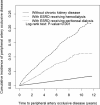Hemodialysis Is Associated With Increased Peripheral Artery Occlusive Disease Risk Among Patients With End-Stage Renal Disease: A Nationwide Population-Based Cohort Study
- PMID: 26181560
- PMCID: PMC4617093
- DOI: 10.1097/MD.0000000000001164
Hemodialysis Is Associated With Increased Peripheral Artery Occlusive Disease Risk Among Patients With End-Stage Renal Disease: A Nationwide Population-Based Cohort Study
Abstract
To investigate the effect of different dialysis modalities on the incidence of peripheral artery occlusive disease (PAOD) among patients with end-stage renal disease (ESRD) in a large population-based cohort study. The cohort study included 26,927 ESRD patients who underwent hemodialysis (17,737 patients, hemodialysis [HD] cohort) or peritoneal dialysis (PD, 9190 patients, PD cohort), and 107,588 matched controls between 2000 and 2010. A Cox proportional hazards model was to evaluate the risk of PAOD in the ESRD underwent HD or PD. Based on a mean follow-up period of 2.92, 3.64, and 4.91 years in the PD, HD, and control cohorts, respectively, the incidences of PAOD were 18.1% and 8.10% higher in the HD and PD cohorts, respectively, compared with the control cohort (log-rank test P < 0.001). The patients who underwent HD or PD exhibited a higher risk of PAOD compared with the control cohort regardless of age, sex, and presence or absence of comorbidities. In addition, the incidence of PAOD in the PD cohort and the propensity score-matched HD cohort were 12.4 and 20.7 per 1000 person-years, respectively, with a hazard ratio of 1.92 (95% confidence interval = 1.62-2.28) in HD patients, compared with the PD cohort. This nationwide population-based cohort study suggested a significantly increased risk of PAOD among ESRD patients. Moreover, the PD patients have a lower risk of developing PAOD compared with the HD cohort, indicating the beneficial roles of PD in reducing PAOD risk in ESRD patients.
Conflict of interest statement
The authors have no conflicts of interest to disclose.
Figures
References
-
- Brevetti G, Giugliano G, Brevetti L, et al. Inflammation in peripheral artery disease. Circulation 2010; 122:1862–1875. - PubMed
-
- Berger JS, Hiatt WR. Medical therapy in peripheral artery disease. Circulation 2012; 126:491–500. - PubMed
-
- Hirsch AT. Treatment of peripheral arterial disease – extending “intervention” to “therapeutic choice”. N Engl J Med 2006; 354:1944–1947. - PubMed
-
- Cheng SW, Ting AC, Wong J. Fasting total plasma homocysteine and atherosclerotic peripheral vascular disease. Ann Vasc Surg 1997; 11:217–223. - PubMed
-
- Ridker PM, Cushman M, Stampfer MJ, et al. Plasma concentration of C-reactive protein and risk of developing peripheral vascular disease. Circulation 1998; 97:425–428. - PubMed
Publication types
MeSH terms
LinkOut - more resources
Full Text Sources
Medical


